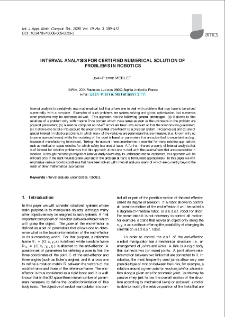Zielonogórska Biblioteka Cyfrowa udostępnia 65 391 obiektów cyfrowych
Obiekt
Tytuł: Interval analysis for certified numerical solution of problems in robotics
Współtwórca:
Rauh, Andreas - ed. ; Auer, Ekaterina - ed. ; Hofer,Eberhard P. - ed. ; Luther, Wolfram - ed.
Podtytuł:
Tytuł publikacji grupowej:
Abstract:
Interval analysis is a relatively new mathematical tool that allows one to deal with problems that may have to be solved numerically with a computer. Examples of such problems are system solving and global optimization, but numerous other problems may be addressed as well. ; This approach has the following general advantages: (a) it allows to find solutions of a problem only within some finite domain which make sense as soon as the unknowns in the problem are physical parameters; (b) numerical computer round-off errors are taken into account so that the solutions are guaranteed; (c) it allows one to take into account the uncertainties that are inherent to a physical system. ; Properties (a) and (c) are of special interest in robotics problems, in which many of the variables are parameters that are measured (i.e., known only up to some bounded errors) while the modeling of the robot is based on parameters that are submitted to uncertainties (e.g., because of manufacturing tolerances). Taking into account these uncertainties is essential for many robotics applications such as medical or space robotics for which safety is a crucial issue. ; A further inherent property of interval analysis that is of interest for robotics problems is that this approach allows one to deal with the "uncertainties" that are unavoidable in robotics. Although the basic principles of interval analysis are easy to understand and to implement, this approach will be efficient only if the right heuristics are used and if the problem at hand is formulated appropriately. In this paper we will emphasize various robotics problems that have been solved with interval analysis, many of which are currently beyond the reach of other mathematical approaches.
Wydawca:
Zielona Góra: Uniwersytet Zielonogórski
Identyfikator zasobu:
DOI:
Strony:
Źródło:
AMCS, volume 19, number 3 (2009) ; kliknij tutaj, żeby przejść
Jezyk:
Licencja CC BY 4.0:
Prawa do dysponowania publikacją:
Biblioteka Uniwersytetu Zielonogórskiego
Kolekcje, do których przypisany jest obiekt:
- Zielonogórska Biblioteka Cyfrowa > Repozytorium > Jednostki organizacyjne > Wydział Informatyki, Elektrotechniki i Automatyki
- Zielonogórska Biblioteka Cyfrowa > Repozytorium > Typy utworów > Artykuły
- Zielonogórska Biblioteka Cyfrowa > Repozytorium > Czasopisma naukowe i serie wydawnicze UZ > International Journal of Applied Mathematics and Computer Science (AMCS) > International Journal of Applied Mathematics and Computer Science (AMCS) (2009)
Data ostatniej modyfikacji:
14 lip 2025
Data dodania obiektu:
9 kwi 2024
Liczba wyświetleń treści obiektu:
92
Wszystkie dostępne wersje tego obiektu:
https://www.zbc.uz.zgora.pl/publication/88554
Wyświetl opis w formacie RDF:
Wyświetl opis w formacie OAI-PMH:
-
-
-
-
-
-
-
-
-
-
-
-
-
-
-
-
-
-
-
International Journal of Applied Mathematics and Computer Science (AMCS), volume 19, number 1 (2009)
-
International Journal of Applied Mathematics and Computer Science (AMCS), volume 19, number 2 (2009)
-
International Journal of Applied Mathematics and Computer Science (AMCS), volume 19, number 3 (2009)
-
International Journal of Applied Mathematics and Computer Science (AMCS), volume 19, number 4 (2009)
-
-
-
-
-
-
-
-
-
-
-
-
-
-
-
-
-
-
-
| Nazwa wydania | Data |
|---|---|
| Interval analysis for certified numerical solution of problems in robotics | 14 lip 2025 |
Obiekty Podobne
Szpakowska, Aleksandra Artiemjew, Piotr Cybowski, Wojciech Campagner, Andrea - ed. Lenz, Oliver Urs - ed. Xia, Shuyin - ed.
Walas, Krzysztof Belter, Dominik Korbicz, Józef (1951- ) - red. Uciński, Dariusz - red.
Chen, Lei Zielińska, Teresa Wang, Jikun Ge, Weimin Korbicz, Józef (1951- ) - red. Uciński, Dariusz - red.
Pepy, Romain Kieffer, Michel Walter, Eric Rauh, Andreas - ed. Auer, Ekaterina - ed. Hofer,Eberhard P. - ed. Luther, Wolfram - ed.
Enszer, Joshua A. Stadtherr, Mark A. Rauh, Andreas - ed. Auer, Ekaterina - ed. Hofer,Eberhard P. - ed. Luther, Wolfram - ed.
Tran, Tuan Anh Jauberthie, Carine Trave-Massuyés, Louise Lu, Quoc Hung Korbicz, Józef (1951- ) - red. Uciński, Dariusz - red.
Mnasri, Chaouki Gasmi, Moncef Korbicz, Józef (1951- ) - red. Uciński, Dariusz - red.
Rauh, Andreas Minisini, Johanna Hofer, Eberhard P. Rauh, Andreas - ed. Auer, Ekaterina - ed. Hofer,Eberhard P. - ed. Luther, Wolfram - ed.

